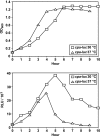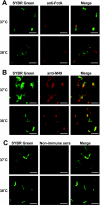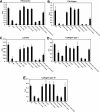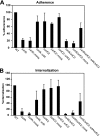Mode of expression and functional characterization of FCT-3 pilus region-encoded proteins in Streptococcus pyogenes serotype M49
- PMID: 18852238
- PMCID: PMC2612252
- DOI: 10.1128/IAI.00772-08
Mode of expression and functional characterization of FCT-3 pilus region-encoded proteins in Streptococcus pyogenes serotype M49
Abstract
The human pathogen Streptococcus pyogenes (group A streptococcus [GAS]) pilus components, suggested to play a role in pathogenesis, are encoded in the variable FCT (fibronectin- and collagen-binding T-antigen) region. We investigated the functions of sortase A (SrtA), sortase C2 (SrtC2), and the FctA protein of the most prevalent type 3 FCT region from a serotype M49 strain. Although it is considered a housekeeping sortase, SrtA's activity is involved in pilus formation in addition to its essentiality for GAS extracellular matrix protein binding, host cell adherence/internalization, survival in human blood, and biofilm formation. SrtC2 activity is crucial for pilus formation but dispensable for the other phenotypes tested in vitro. FctA is the major pilus backbone protein, simultaneously acting as the M49 T antigen, and requires SrtC2 and LepA, a signal peptidase I homologue, for monomeric surface expression and polymerization, respectively. Collagen-binding protein Cpa expression supports pilus formation at the pilus base. Immunofluorescence microscopy and fluorescence-activated cell sorting analysis revealed several unexpected expression patterns, as follows: (i) the monomeric pilus protein FctA was found exclusively at the old poles of GAS cells, (ii) FctA protein expression increased with lower temperatures, and (iii) FctA protein expression was restricted to 20 to 50% of a given GAS M49 population, suggesting regulation by a bistability mode. Notably, disruption of pilus assembly by sortase deletion rendered GAS serotype M49 significantly more aggressive in a dermonecrotic mouse infection model, indicating that sortase activity and, consequently, pilus expression allow a subpopulation of this GAS serotype to be less aggressive. Thus, pilus expression may not be a virulence attribute of GAS per se.
Figures











Similar articles
-
Role of streptococcal T antigens in superficial skin infection.J Bacteriol. 2007 Feb;189(4):1426-34. doi: 10.1128/JB.01179-06. Epub 2006 Sep 29. J Bacteriol. 2007. PMID: 17012387 Free PMC article.
-
Identification and Characterization of Serotype-Specific Variation in Group A Streptococcus Pilus Expression.Infect Immun. 2018 Jan 22;86(2):e00792-17. doi: 10.1128/IAI.00792-17. Print 2018 Feb. Infect Immun. 2018. PMID: 29158432 Free PMC article.
-
Characterization of M-Type-Specific Pilus Expression in Group A Streptococcus.J Bacteriol. 2022 Nov 15;204(11):e0027022. doi: 10.1128/jb.00270-22. Epub 2022 Oct 26. J Bacteriol. 2022. PMID: 36286511 Free PMC article.
-
The intracellular status of Streptococcus pyogenes: role of extracellular matrix-binding proteins and their regulation.Int J Med Microbiol. 2004 Sep;294(2-3):177-88. doi: 10.1016/j.ijmm.2004.06.017. Int J Med Microbiol. 2004. PMID: 15493828 Review.
-
Streptococcus pyogenes biofilms-formation, biology, and clinical relevance.Front Cell Infect Microbiol. 2015 Feb 11;5:15. doi: 10.3389/fcimb.2015.00015. eCollection 2015. Front Cell Infect Microbiol. 2015. PMID: 25717441 Free PMC article. Review.
Cited by
-
Pilus biogenesis in Lactococcus lactis: molecular characterization and role in aggregation and biofilm formation.PLoS One. 2012;7(12):e50989. doi: 10.1371/journal.pone.0050989. Epub 2012 Dec 6. PLoS One. 2012. PMID: 23236417 Free PMC article.
-
Serotype- and strain- dependent contribution of the sensor kinase CovS of the CovRS two-component system to Streptococcus pyogenes pathogenesis.BMC Microbiol. 2010 Feb 1;10:34. doi: 10.1186/1471-2180-10-34. BMC Microbiol. 2010. PMID: 20113532 Free PMC article.
-
Streptococcus pyogenes Endopeptidase O Contributes to Evasion from Complement-mediated Bacteriolysis via Binding to Human Complement Factor C1q.J Biol Chem. 2017 Mar 10;292(10):4244-4254. doi: 10.1074/jbc.M116.749275. Epub 2017 Jan 30. J Biol Chem. 2017. PMID: 28154192 Free PMC article.
-
Tissue tropisms in group A Streptococcus: what virulence factors distinguish pharyngitis from impetigo strains?Curr Opin Infect Dis. 2016 Jun;29(3):295-303. doi: 10.1097/QCO.0000000000000262. Curr Opin Infect Dis. 2016. PMID: 26895573 Free PMC article. Review.
-
T4 Pili Promote Colonization and Immune Evasion Phenotypes of Nonencapsulated M4 Streptococcus pyogenes.mBio. 2020 Jul 21;11(4):e01580-20. doi: 10.1128/mBio.01580-20. mBio. 2020. PMID: 32694142 Free PMC article.
References
-
- Abbot, E. L., W. D. Smith, G. P. Siou, C. Chiriboga, R. J. Smith, J. A. Wilson, B. H. Hirst, and M. A. Kehoe. 2007. Pili mediate specific adhesion of Streptococcus pyogenes to human tonsil and skin. Cell. Microbiol. 91822-1833. - PubMed
-
- Barocchi, M. A., J. Ries, X. Zogaj, C. Hemsley, B. Albiger, A. Kanth, S. Dahlberg, J. Fernebro, M. Moschioni, V. Masignani, K. Hultenby, A. R. Taddei, K. Beiter, F. Wartha, A. von Euler, A. Covacci, D. W. Holden, S. Normark, R. Rappuoli, and B. Henriques-Normark. 2006. A pneumococcal pilus influences virulence and host inflammatory responses. Proc. Natl. Acad. Sci. USA 1032857-2862. - PMC - PubMed
Publication types
MeSH terms
Substances
LinkOut - more resources
Full Text Sources
Other Literature Sources
Miscellaneous

